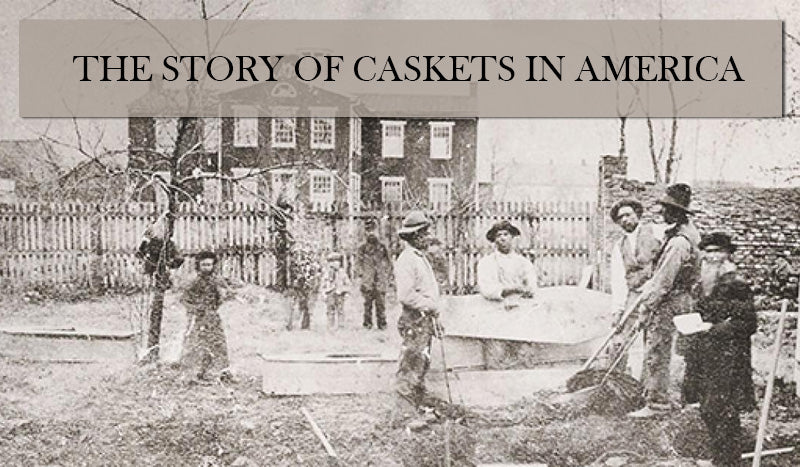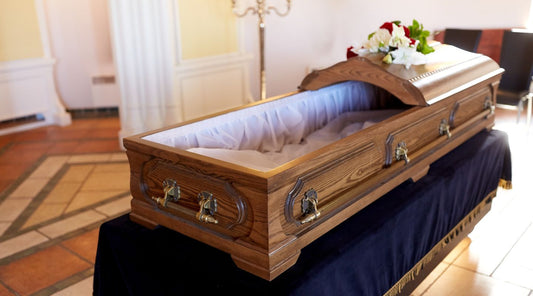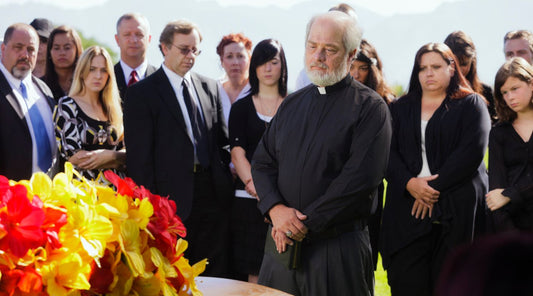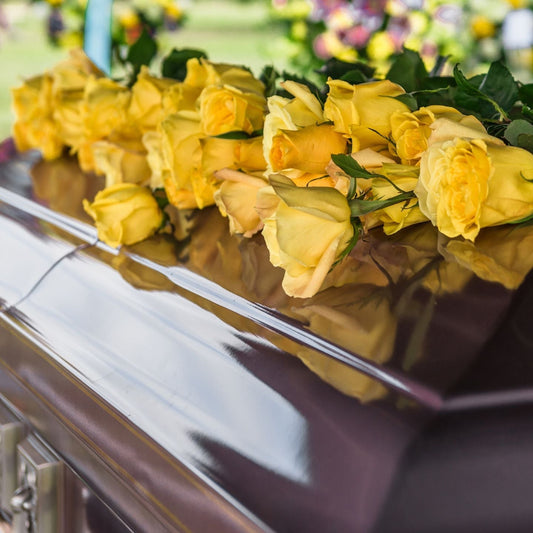
The Story of Caskets in America
From Coffins to Caskets - an American History
We have to admit that most of us don’t like to talk about death, funerals, or anything related. Unfortunately, everybody will have to deal with it at some point in life, so it is not a bad idea to be prepared and have some knowledge about the topic.
Apart from the many and various funeral rules, rituals, and things to organize, one of the main matters to know about is caskets, or should we say coffins? Is it a casket or a coffin? Are they different or not? Keep reading to find out more about the exciting history of caskets and coffins on the North American continent.
Casket or coffin? What’s the difference?
In a nutshell, caskets and coffins are used interchangeable, even if they do present some differences. The shape of the two differs, with the coffin having six sides and being hexagonal, whereas the casket is rectangular and shows four sides. But that’s a general description, as the coffin doesn't typically come with a hinged lid, for example.
According to historians, the coffin disappeared in the States many years ago, as the Americans preferred caskets better than coffins. How the coffin became a casket is also interesting, since this transformation has both social and economic reasons, with the 19th century America as the turning point in this evolution.
Traveling back in time - the 1700s
Without going too much into details, the British colonies in North America were commonly known as British America and the British West Indies until late 1700 (1776). It was then when the thirteen British colonies along the Atlantic seaboard proclaimed their independence, turning into the United States.
In 1700, the English law permitted all people to use coffins for burials. Before the 1700s, coffins were used for the wealthier, whereas the poorest citizens were buried in winding-sheet or shrouds and placed directly into the ground. The “parish coffin” was the single kind of coffin during this period; it was a vessel for carrying the body from the church to the graveside, adding a particular dignity to the moment.
What happened in England is important for the U.S. too because back then, the British American colonies didn't differ much in their customs. Coffins would be used in Maryland 90% of the time at the beginning of the 1700s. English mourning rituals would also be used in colonial America, with the coffin as the center of attention for the funeral rituals.
The term "coffin"
The Old French “coffin” (it means a small basket) gave the English term “coffin." The word would name a casket, chest, and even a pie. In 1700, the coffin was mostly hexagonal, with six sides, and tapered at the feet and shoulders.

The tapered top half of the coffin was made to fit the shoulders of the deceased comfortably, and the final anthropometric shape relates to the size and proportions of the body. It was also quite tricky to solve for some people.
We should highlight that four-sided coffins were also used in Britain and became the norm for English funerals during the 18th century. At some point, the term “coffin” was used no matter the number of sides the vessel would have. Back in the 18th century, people wouldn't use the word "casket" just yet.
The casket comes into the picture
From 1700 until the mid 19th century, hexagonal coffins were the most common choice for people in the North American colonies. There are several opinions about why the North-Americans dropped the coffins and started using caskets instead.

Rectangular coffins were very popular before the American civil war (1861-1865), and most historians agree that it was the war that pushed people to turn to caskets instead of coffins. In America, coffins used to be quite plain and made of wood nine times out of ten. If the coffin furniture business was quite flourishing in Britain, we could not say the same about America. But the civil war did cause an immense transformation in terms of American funerary rituals.
For example, during the American civil war, the Americans started to use embalming, whereas the coffins would still have a fundamental design.
The war's violence and the high numbers of death cause the effect commonly known as “the beautification of death” during the civil war, becoming the turning point for coffins. People would try to take some distance from death, changing the coffin's name and shape as an attempt to make death less painful. The first American caskets would still have six sides, but they would more massive, without tapering at the bottom.
Early caskets would have six sides but looked rather like caskets today and not the coffins. Casket-bar handles (a bar that runs along the side of the casket) and not the typical individual handles on coffins would be present on the early caskets.
We can assume that people would see the coffins as too plain, too revealing, and altogether unrefined. The name had to be changed, as “casket” would send one thinking of vessels carrying valuable goods. The term would also show increased respect for the deceased and the funeral ritual. Many Americans would believe that the caskets make the better choice for honoring the departed.
Did the funeral rituals change?
After the revolutionary period, the traditional British rituals with public mourning have started to fade slowly, turning into practices specific to north-Americans. Suddenly, north-Americans would recommend people purchase local fabrics for the mourning clothing and give up the imported materials. People felt the need to replace imitation of rituals from across the seas with genuine American traditions. They slowly added specific practices, even though the funeral rituals would still have English roots. The change also affected people’s opinion on coffins.
The coffin has traveled across the Atlantic and was used by the first English settlers, but it was used for only 150 years. The “new” country had its own opinions on death, so everything related to it had to change as well.
The 20th Century

When the 20th century begun, caskets replaced all coffins in America. The casket does look like an improved coffin made by the Americans; after all, it’s polished and stands out as an upgraded model of the coffin, with little to no resemblance to the old funeral container.
What about the casket industry? How old is it?
The casket industry goes back into ancient Mesopotamia and Egypt, where cloth, paper, and wood made materials for the burial boxes. The late 19th century was when casket manufacturing was born and developed in the united states and turned into the $ 1.2 billion industry that it is today.
In Europe, the Celts made caskets of flat stones back in 700, and for many centuries, only nobility and aristocrats would use caskets.
As for the united states, the casket industry started with the local cabinet and furniture manufacturers who would also work as funeral directors. They would make wood caskets as-needed basis; thousands of caskets had to be made for the dead soldiers during the Civil War. That's the starting point for the mass-produced casket period.
Steel caskets have emerged on the market at the end of the 1840s when dr. Almond fisk was offered a U.S. patent for the cast-iron casket. He advertised the casket as impossible to destroy and airtight. It was a "metallic burial case" with a bronze finish and glass lid so that the mourners may still see the dead.
It was only the late 19th century when casket manufacturing had become the specific business we know today. We should also highlight that most companies would cover only regional and local areas, unlike today's national coverage companies.
Today, some of the most popular casket manufactures have started early in the business, with Batesville casket as the most popular to note.
Batesville casket was born in 1884 when they would hand made wooden coffins in Indiana. Later in 1906, Hillenbrand bought the company. One of Hillenbrand’s son took the business to the next level and achieved over 40 U.S. patents. He was the first to mass-produce the metal-gasketed caskets, known back then as Monoseal.
There were over 700 casket manufacturers at the beginning of the 50s, but only 147 of the companies were still running in 2003. Nowadays, less than a dozen manufacturers account for together 90% of the metal caskets sold across the U.S.
While Costco Wholesale Corp pulled the trigger on selling steel caskets at low costs, many other online businesses are popular choices for customers today. Walmart is also joined the list of the online casket retailers. Modern people like to have many options, and online companies offer myriads of options, with prices matching budgets of all sizes.
People today can find caskets starting as low as $700 in online shops and as expensive as $10.000 (and even higher than that). It’s comforting to know we have so many options, but we need to clear things out and use various criteria before purchasing. Choosing the casket isn’t as easy as in the 1900s, but you can select the casket you like the most, without even emptying your wallet like in the 19th century.
Blog Author: Tim



